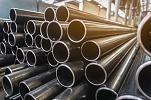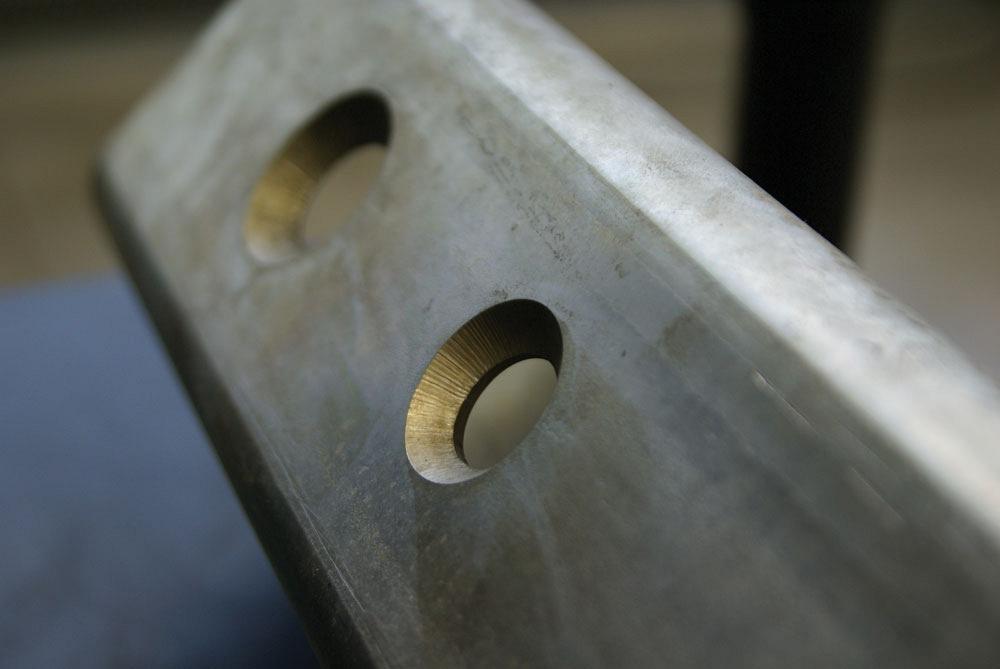senior application engineer
- FMA
- The Fabricator
- FABTECH
- Canadian Metalworking
Optimize processing with a laser tube cutting machine
Today’s tube lasers offer a done-in-one system for fast and efficient cutting
- By Garrett Peterson
- Updated February 13, 2023
- November 18, 2019
- Article
- Fabricating

With tube cutting, the operator needs to be aware of the other side of the tube and the affect the laser will have on it while processing the cut, particularly as it relates to thermal expansion.
Laser cutting technology has significantly moved the needle for fast processing of flat sheet metal. But what about cutting tube and pipe? Today’s laser tube cutting machines are specifically designed to cut a large range of mill-length tube and pipe, whether round, square, rectangular, or triangular. Some of the more advanced options can process I- and H-beams, C-channel, angle iron, and other user-defined shapes.
Cutting tube and pipe using a laser is similar in a lot of ways to processing flat sheet metal. A lot of tube is made from the same material as the flat metal is made from, as it starts out flat before it is formed into the tube. However, there are some significant differences between the two. With tube cutting, the operator needs to be aware of the other side of the tube and the effect the laser will have on it while processing the cut, particularly as it relates to thermal expansion.
When cutting flat material, a laser will throw off sparks, debris, and slugs, which generally land on the table or into a chip bucket. But with laser tube cutting, those sparks, debris, and slugs often fall inside of the tubing. That could be an issue for some fabricators, which is why they need to be aware of this and learn how to deal with it effectively. It’s always important to keep in mind how to properly manage scrap material, dross, and slugs.
To deal with the sparks going inside the tube, fabricators can precoat the inside of the tube with an antispatter to help prevent the sticking of the dross to the inside of the tube. They can also use a sacrificial tube on the inside to absorb the laser beam to prevent heat buildup and damage to the other side. In some cases, fabricators can opt for a secondary process to clean the inside of the tube once it’s been cut. This all depends on the fabricator’s industry standard and application.
Tube Cutting Basics
There are some significant differences between laser cutting tube versus flat sheets. Operators need to be aware that cutting tube requires an ideal finished cut so the machine can move on to the next part. With laser cutting sheet metal, the machine is not affected by the previous part and can simply move on to the next sheet regardless of the quality of cut. It is important that the last cut of the part be of a quality to allow the finished part to be separated from the unprocessed material stick. If the finished part does not separate it can present a challenge for the unloading process and can also present a challenge for the start of the next part if the previous part does not separate properly from the raw material.
One of the most basic things operators can do to ensure that the machine is efficiently cutting tube is to visually inspect the cut to make sure it has been done properly. With end cuts, the last cut of the part will determine if the part can be separated from the raw material stick, which makes it necessary to ensure good cut quality. If the last cut of the finished part does not allow for the separation, the machine cannot continue to the next part.
Those who have experience cutting tube know that the tubes themselves are not always straight. For those just entering the laser tube cutting sphere, it is certainly something that needs to be considered from both the operator and programmer perspectives.
When ordering tube, shops may opt for a less expensive material, and this will directly correlate with the quality of the final product. Fabricators need to be concerned with whether or not the tubing is straight. If it is not straight, they need to determine if the machine has the capability to correct for non-straight tubing. While it is not only the machine operator’s duty to know tube straightness, it is also the programmer’s. When an engineer has designed a part, programmers, supervisors, and managers all have to take into account how well the drawing matches up to the material being used and the accuracy of the cutting processes.
For example, if a shop is working with a 4- by 4-in. square tube in mild steel, the material will typically have corner radii. Before cutting, it is important to know how accurate the corner radii are. This is especially relevant when it comes to programming, which needs to ensure that the digital print matches the reality of what is being cut on the shop floor. If the material and the digital print are not the same, the end result may not be as expected. For example, bevels may not meet up because the corner radii are different. There are loose standards and tolerances on standard tubing. Many advanced laser tube cutting machines include compensations for feature overrides like a corner radius to ensure the part can still be cut correctly.
Weld Seam
Infrequently, some parts require the weld seam to be located on a certain side, or its location is sensitive to the overall design. In these instances, laser tube cutting machines can include a seam detector that will locate the seam so cutting can be adjusted accordingly. This is particularly significant in parts where bearings are being placed in the tube, if tapped holes will be introduced, or when another part needs to attach to that area. However, in today’s material market, shops have the option to spend a little more money and purchase seamless tube or pipe so it no longer is an issue.

Tube lasers can be used to cut shapes and features that can’t be made with other methods. The more features on a part, the faster the return on investment a fabricator will get from the tube laser.
Maximizing Efficiency
With many systems available on the market, finding the right laser tube cutting machine requires some thought. Tube lasers are based on the size it can handle, so a shop needs to know what tube dimensions it is expecting to cut. This will ensure that it can cut the largest-diameter tube the shop will be working with.
Questions a fabricator needs to answer are, first, what tube size will be cut, how much power is needed, and the length of the tube. The answers will determine the size of the machine needed.
How long lengths of tube are supported is important. Finding a tube laser system that has proper support for the raw stick can make all the difference in part quality. The more chucks on a system, the greater the accuracy will be when the tube is rotating. The ability to support tubing on both sides of the cut is important because inaccuracies can occur if the tube is hanging and unsupported. Having a third and fourth chuck will help hold and help with accuracy of a part. Also, with four chucks, chuck one and chuck two can be cutting raw material while chuck three and chuck four are removing the finished part away from the cutting area and unloaded, enabling higher throughput.
Most tube laser machines today have the capability to tilt the head to allow for bevel cutting and countersinks. A machine with a 3D torch maximizes flexibility and the range of movement, which expands the range of applications possible. Fabricators are able to cut any desired angle for weld prep plus achieve the highest accuracy for easy assembly fit-ups.
Automation is also something that can make laser tube cutting more efficient. Something as simple as raw material length detection on the machine can measure the length of stick using sensors for better material management. Features like automatic loading and unloading systems, seam detection, and spatter extraction can increase a machine’s efficiency for producing quality parts.
Done-in-One
Some misconceptions about tube lasers are common. Many operators are unaware of how much faster it is to cut tube on a laser cutting system than with other methods. A laser tube cutting machine is expensive, and some fabricators don’t want to invest in one just to cut raw stick that could be cut faster on a band saw. Some shops don’t want to use a band saw because it tends to be less accurate than a tube laser and the tube needs postprocessing such as grinding.
But tube lasers can be used to cut shapes and features that can’t be made with other methods. These features will help fabricators expand capabilities to take on a wider range of customer projects. The more features on a part, the faster the return on investment a fabricator will get from the tube laser.
A laser tube cutting machine acts as a done-in-one system by performing a number of processes, including material handling, cutting, machining, drilling, tapping, and punching. This eliminates the operator’s need to work through multiple steps moving from machine to machine.
Garrett Peterson is a senior application engineer at Mazak Optonics Corp., 2725 Galvin Court, Elgin, Ill. 60124, 847-252-4500, www.mazakoptonics.com.
Photos courtesy of Mazak Optonics.
About the Author
Related Companies
subscribe now


Keep up to date with the latest news, events, and technology for all things metal from our pair of monthly magazines written specifically for Canadian manufacturers!
Start Your Free Subscription- Trending Articles
BlueForge Alliance partners with Nuts, Bolts & Thingamajigs to develop Submarine Manufacturing Camps

Portable system becomes hot tech in heat treatment

Orbital tube welding webinar to be held April 23

Cidan Machinery Metal Expo 2024 to be held in Georgia May 1-2

Corrosion-inhibiting coating can be peeled off after use

- Industry Events
MME Winnipeg
- April 30, 2024
- Winnipeg, ON Canada
CTMA Economic Uncertainty: Helping You Navigate Windsor Seminar
- April 30, 2024
- Windsor, ON Canada
CTMA Economic Uncertainty: Helping You Navigate Kitchener Seminar
- May 2, 2024
- Kitchener, ON Canada
Automate 2024
- May 6 - 9, 2024
- Chicago, IL
ANCA Open House
- May 7 - 8, 2024
- Wixom, MI
















